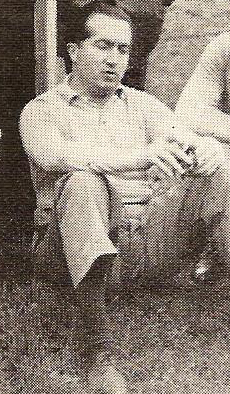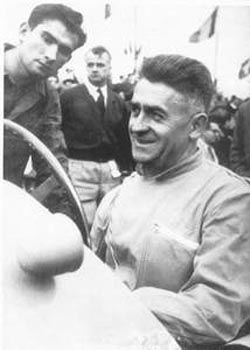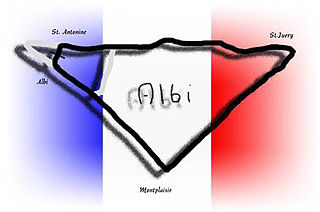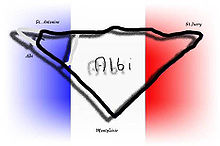
Maurice Bienvenu Jean Paul Trintignant was a motor racing driver and vintner from France. He competed in the Formula One World Championship for fourteen years, between 1950 and 1964, one of the longest careers in the early years of Formula One. During this time he also competed in sports car racing, including winning the 1954 24 Hours of Le Mans race. Following his retirement from the track Trintignant concentrated on the wine trade.

The 1951 British Grand Prix was a Formula One motor race held on 14 July 1951 at the Silverstone Circuit in Northamptonshire, England. It was race 5 of 8 in the 1951 World Championship of Drivers and was contested over 90 laps. The race was the first victory for José Froilán González, and was also the first of many for the Scuderia Ferrari team. Both the team and driver also achieved their first ever pole position during the weekend.

The 1951 Italian Grand Prix was a Formula One motor race held on 16 September 1951 at Monza. It was race 7 of 8 in the 1951 World Championship of Drivers.

The 1952 French Grand Prix was a Formula Two race held on 6 July 1952 at Rouen-Les-Essarts. It was race 4 of 8 in the 1952 World Championship of Drivers, in which each Grand Prix was run to Formula Two rules rather than the Formula One regulations normally used. Unusually this race was run over a duration of 3 hours, rather than a fixed distance.

The 1952 Dutch Grand Prix was a Formula Two race held on 17 August 1952 at the Circuit Zandvoort. It was race 7 of 8 in the 1952 World Championship of Drivers, in which each Grand Prix was run to Formula Two rules rather than the Formula One regulations normally used. The 90-lap race was won by Ferrari driver Alberto Ascari after he started from pole position. His teammates Giuseppe Farina and Luigi Villoresi finished in second and third places. Ascari overtook Fangio's record for the most race wins, scoring his seventh at this race.

The 1952 Italian Grand Prix was a Formula Two race held on 7 September 1952 at Monza. It was the eighth and final round of the 1952 World Championship of Drivers, in which each Grand Prix was run to Formula Two rules rather than the Formula One regulations normally used. The 80-lap race was won by Ferrari driver Alberto Ascari after he started from pole position. José Froilán González finished second for the Maserati team and Ascari's teammate Luigi Villoresi came in third.

The 1953 Argentine Grand Prix was race 1 of 9 in the 1953 World Championship of Drivers, which was run to Formula Two regulations in 1952 and 1953. The race was held in Buenos Aires on 18 January 1953, at the Autódromo Gálvez and was the first World Drivers' Championship race in South America.

The 1953 Dutch Grand Prix was a Formula Two race held on 7 June 1953 at the Circuit Zandvoort. It was race 3 of 9 in the 1953 World Championship of Drivers, which was run to Formula Two rules in 1952 and 1953, rather than the Formula One regulations normally used. The 90-lap race was won by Ferrari driver Alberto Ascari after he started from pole position. His teammate Nino Farina finished second and Maserati drivers José Froilán González and Felice Bonetto came in third

The 1953 Belgian Grand Prix was a Formula Two race held on 21 June 1953 at Circuit de Spa-Francorchamps. It was race 4 of 9 in the 1953 World Championship of Drivers, which was run to Formula Two rules in 1952 and 1953, rather than the Formula One regulations normally used. The 36-lap race was won by Ferrari driver Alberto Ascari after he started from second position. His teammate Luigi Villoresi finished second and Maserati driver Onofre Marimón came in third.

The 1953 French Grand Prix was a Formula Two race held on 5 July 1953 at Reims. It was race 5 of 9 in the 1953 World Championship of Drivers, which was run to Formula Two rules in 1952 and 1953, rather than the Formula One regulations normally used.

The 1952 Formula One season was the sixth season of FIA Formula One motor racing. In comparison to previous seasons, the 1952 season consisted of a relatively small number of Formula One races, following the decision to run all the Grand Prix events counting towards the World Championship of Drivers to Formula Two regulations rather than Formula One. The Indianapolis 500, which also counted towards the World Championship, was still run to AAA regulations as in previous seasons.

The 1951 Formula One season was the fifth season of FIA Formula One motor racing. It featured the 1951 World Championship of Drivers, which commenced on 27 May 1951 and ended on 28 October after eight races. The season also included 14 races open to Formula One cars but did not count towards the championship standings.

Louis Rosier was a racing driver from France.

The 1950 Albi Grand Prix was a non-championship Formula One race held on 16 July 1950.

The 20th Circuito di Pescara was a Formula One motor race, held on 15 August 1951, at the Pescara Circuit in Abruzzo, Italy. José Froilán González in a Ferrari 375 won and set fastest lap. Louis Rosier and Philippe Étancelin were second and third in their Talbot-Lago T26Cs. Alberto Ascari in another Ferrari 375 started from pole position but retired on the first lap; he took over teammate Luigi Villoresi's car but retired that car also.

The XIII Grand Prix d'Albi was a motor race, run to Formula One rules, held on 5 August 1951 at the Circuit Les Planques, Albi. The race was run over 34 laps of the circuit, and was won by French driver Maurice Trintignant in a Simca-Gordini Type 15. Trintignant also set pole and fastest lap. Louis Rosier and Louis Chiron were second and third in their Talbot-Lago T26Cs.

The XIV Grand Prix de l'Albigeois was a Formula One motor race held on 1 June 1952 at Circuit Les Planques, Albi, France. The race was won by Louis Rosier in a Ferrari 375 Chico Landi was second in another 375 and Yves Giraud-Cabantous third in a Talbot-Lago T26C. BRM drivers Juan Manuel Fangio and José Froilán González took pole and fastest lap respectively, but both retired with mechanical problems.
The 4th Circuit de Cadours was a Formula Two motor race held on 14 September 1952 at the Circuit de Cadours, in Cadours, Tarn-et-Garonne, France. The race, consisting of 2x15 lap heats and a 30 lap final, was won by Louis Rosier in a Ferrari 500. Harry Schell finished second in a Gordini Type 16, and set fastest lap, and Emmanuel de Graffenried was third in a Maserati 4CLT/48.

The 5th Circuit du Lac was a Formula Two motor race held on 26 July 1953 at the Aix-les-Bains Circuit du Lac, France. The race was run over two heats each of 50 laps, with the winner being decided by aggregate time. The winner was Élie Bayol in an O.S.C.A. Tipo 20, finishing second and first in the two heats. Louis Rosier was second in a Ferrari 500 and Lance Macklin third in a HWM-Alta. Gordini driver Jean Behra won the first heat and set fastest overall lap during heat 2, and his teammate Harry Schell set pole position and fastest lap for heat 1, but both retired with mechanical problems.

The 9th Grand Prix de l'Albigeois was a Formula One motor race held on 13 July 1947 at Les Planques circuit in Albi in the Tarn department of France. The winner of the 40 lap race was Louis Rosier in a Talbot-Lago T150SS. Second was Raymond Sommer in a Simca Gordini Type 11 and Charles Pozzi was third in a Delahaye 135. Maserati drivers Henri Louveau and Luigi Villoresi set pole and fastest lap respectively, but both retired.














